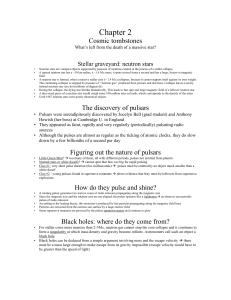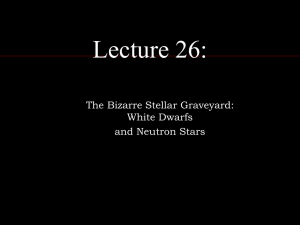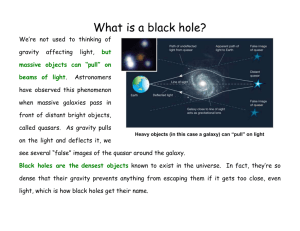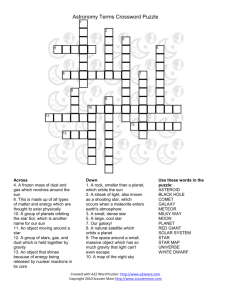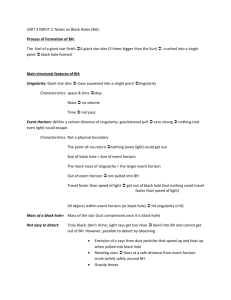Today's Powerpoint
advertisement
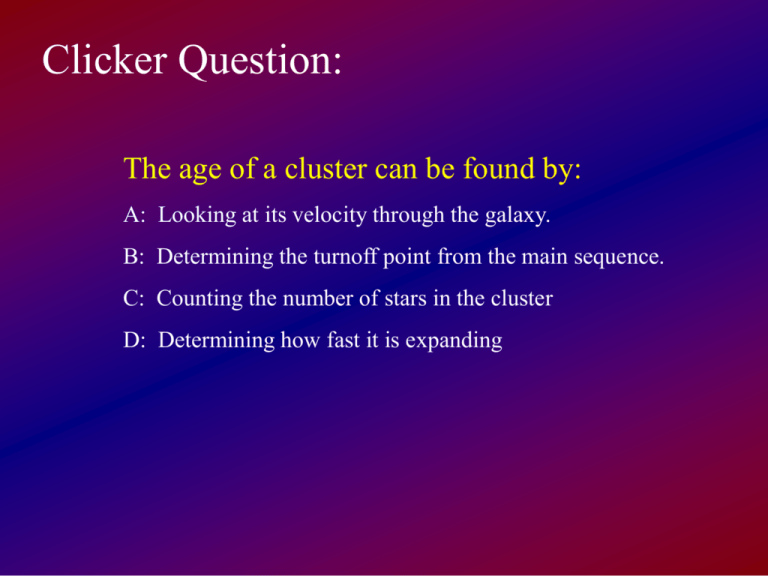
Clicker Question: The age of a cluster can be found by: A: Looking at its velocity through the galaxy. B: Determining the turnoff point from the main sequence. C: Counting the number of stars in the cluster D: Determining how fast it is expanding Clicker Question: Why do globular clusters contain stars with fewer metals (heavy elements) compared to open clusters? A: Open clusters have formed later in the evolution of the universe after considerably more processing B: Metals are gradually destroyed in globular clusters. C: Metals are blown out of globular clusters during supernova explosions D: Metals spontaneously decay to lighter elements during the 10 billion year age of the globular cluster. An early gamma ray-burst Vela satellite A Gamma Ray Burst Sampler Great debate: 1967-1997 Bepposax Satellite GRBM: 40-600 keV WFC: 2-30 keV NFI: 2-10 keV X-Ray Afterglow from GRB 971214 t=6.5 hrs t=12.5 hrs t=54 hrs Optical Afterglow from GRB 971214 Keck Images 2 days 2 months Host HST Image Uh-oh GRBs are a type of Supernova “Hypernova” ● Peak toward low end of gamma-ray, complex gamma-ray light curves ● Often have bright afterglows ● Evidence for a relativistic explosion ● Energy required of ~ 1053 ergs (isotropic) ● Associated with regions of star formation in distant galaxies (out to edge of observable universe) ● Sometimes obscured by dust ● Plus … Example Hypernova: 1998bw Long GRBs clearly connected to Supernovae Hjorth et al 2003 Final States of a Star 1. White Dwarf If initial star mass < 8 MSun or so No Event + PN 2. Neutron Star If initial mass > 8 MSun and < 25 MSun Supernova + ejecta 3. Black Hole If initial mass > 25 MSun GRB + Hypernova + ejecta Clicker Question: What is the heaviest element produced by steady fusion in the core of a massive star? A: Hydrogen B: Carbon C: Iron D: Uranium Clicker Question: All of the following atoms have a total of 4 nucleons (protons or neutrons). Which of the following has the smallest mass? A: 4 hydrogen atoms B: 2 deuterium atoms C: 1 tritium atom and 1 hydrogen atom D: 1 Helium atom E: None of the above, they all have the same total mass WR104 - Looking Down the Barrel of a GRB system 8000 lt-years from us Final States of a Star 1. White Dwarf If initial star mass < 8 MSun or so. (and remember: Maximum WD mass is 1.4 MSun , radius is about that of the Earth) 2. Neutron Star If initial mass > 8 MSun and < 25 MSun . 3. Black Hole If initial mass > 25 MSun . Pulsars Discovery of LGM1 by Jocelyn Bell and Tony Hewish (Cambridge) in 1967. Nobel Prize to Hewish in 1974. Pulse periods observed from 0.001 sec to 10 seconds - DEMO Explanation: "beamed" radiation from rapidly spinning neutron star. Usually neutron stars are pulsars for 107 years after supernova. The Crab Pulsar The Crab Pulsar Chandra X-ray image On Off The Crab Pulsar Chandra X-ray image On Off Neutron Stars Leftover core from Type II supernova - a tightly packed ball of neutrons. Diameter: 20 km only! Mass: 1.4 - 3(?) MSun Density: 1014 g / cm3 ! 1 teaspoon = 1000 great pyramids Surface gravity: 1012 higher Escape velocity: 0.5c Rotation rate: few to many times per second!!! Magnetic field: 1012 x Earth's! A neutron star over the Sandias? General Relativistic deflection of light More than half the surface is visible at any one time! Each square is 30 degrees x 30 degrees An Isolated Neutron Star T ~ 2 million K Size ~ 30 km The Lighthouse model of a pulsar Pulsars are incredibly accurate clocks! Example: period of the first discovered "millisecond pulsar" is: P = 0.00155780644887275 sec It is slowing down at a rate of 1.051054 x 10 -19 sec/sec The slowing-down rate is slowing down at a rate of: 0.98 x 10 -31 /sec Multi-wavelength observations of Pulsars Pulsar Exotica Binary pulsars: two pulsars in orbit around each other. Einstein predicted that binary orbits should "decay", i.e. the masses would spiral in towards each other, losing energy through "gravitational radiation". Confirmed by binary pulsar. Curve: prediction of decaying orbit. Points: measurements. Planets around pulsars: A pulsar was found in 1992 to have three planets! Masses about 3 MEarth, 1 MEarth, and 1 MMoon ! year Millisecond pulsars: periods of 1 to a few msec. Probably accreted matter from a binary companion that made it spin faster. Gamma-ray Bursts: some pulsars produce bursts of gamma-rays, called Soft Gamma-Ray Repeaters or SGRs Time history of the 4 confirmed SGRs: Woods & Thompson 2004 Soft Gamma-Ray Repeaters " Eiso ~ a few1044 erg in gamma-rays Where does this energy come from? X-ray image - Accretion? No sign of a disk - Rotation? Not enough energy available - Magnetic fields? Yes Clicker Question: What is our basic model for a pulsar? A: a rotating white dwarf B: a rotating neutron star C: a rotating black hole D: an oscillating star Clicker Question: Which of the following is true about a binary pulsar system? A: It will last forever. B: They can only be found in star forming regions C: The total mass of the two pulsars must be more than 10 solar masses. D: Each of the pulsars was produced by a massive star that exploded in a Supernova event. NS Merger Model for short GRBs Mean redshift ~ 0.25 for short hard bursts (SHB) No supernova association expected SHBs often found at outskirts of galaxy (implies large peculiar velocities) SHBs found in - Elliptical galaxies - galaxies with low star formation rates Black Holes A stellar mass black hole accreting material from a companion star 34 Black Holes and General Relativity General Relativity: Einstein's description of gravity (extension of Newton's). Published in 1915. It begins with: The Equivalence Principle Let's go through the following series of thought experiments and arguments: 1) Imagine you are far from any source of gravity, in free space, weightless. If you shine a light or throw a ball, it will move in a straight line. 35 2. If you are in freefall, you are also weightless. Einstein says these are equivalent. So in freefall, the light and the ball also travel in straight lines. 3. Now imagine two people in freefall on Earth, passing a ball back and forth. From their perspective, they pass the ball in a straight line. From a stationary perspective, the ball follows a curved path. So will a flashlight beam, but curvature of light path is small because light is fast (but not infinitely so). The different perspectives are called frames of reference. 36 4. Gravity and acceleration are equivalent. An apple falling in Earth's gravity is the same as one falling in an elevator accelerating upwards, in free space. 5. All effects you would observe by being in an accelerated frame of reference you would also observe when under the influence of gravity. 37 Examples: 1) Bending of light. If light travels in straight lines in free space, then gravity causes light to follow curved paths. 38 Observed! In 1919 eclipse by Eddington 39 Gravitational lensing of a single background quasar into 4 objects 1413+117 the “cloverleaf” quasar A ‘quad’ lens 40 Gravitational lensing. The gravity of a foreground cluster of galaxies distorts the images of background galaxies into arc shapes. 41 Saturn-mass black hole 42 Clicker Question: Eddington and his team were able to see a star appear from behind the sun sooner than expected during the 1919 solar eclipse due to: A: bending of the light by heat waves from the sun B: bending of the light due to the mass of the sun C: acceleration of the light to higher speeds by the sun D: bending of the light by strong magnetic fields 43 Clicker Question: Einstein’s equivalence principle states that: A: Mass and Energy are related B: All clocks appear to record time at the same rate regardless of how fast they move. C: Time and Money are related D: An observer cannot distinguish between an accelerating frame due to motion or due to gravity. 44 2. Gravitational Redshift later, speed > 0 light received when elevator receding at some speed. Consider accelerating elevator in free space (no gravity). time zero, speed=0 light emitted when elevator at rest. Received light has longer wavelength (or shorter frequency) because of Doppler Shift ("redshift"). Gravity must have same effect! Verified in Pound-Rebka experiment. 45 3. Gravitational Time Dilation A photon moving upwards in gravity is redshifted. Since 1 T the photon's period gets longer. Observer 1 will measure a longer period than Observer 2. So they disagree on time intervals. Observer 1 would say that Observer 2's clock runs slow! 1 2 All these effects are unnoticeable in our daily experience! They are tiny in Earth’s gravity, but large in a black hole’s. 46 Escape Velocity Velocity needed to escape the gravitational pull of an object. vesc = 2GM R Escape velocity from Earth's surface is 11 km/sec. If Earth were crushed down to 1 cm size, escape velocity would be speed of light. Then nothing, including light, could escape Earth. This special radius, for a particular object, is called the Schwarzschild Radius, RS. RS M. 47 Black Holes If core with about 3 MSun or more collapses, not even neutron pressure can stop it (total mass of star about 25 MSun). Core collapses to a point, a "singularity". Gravity is so strong that nothing can escape, not even light => black hole. Schwarzschild radius for Earth is 1 cm. For a 3 MSun object, it’s 9 km. 48 Clicker Question: X-rays coming from the surface of a neutron star observed at Earth are shifted to: A: lower energies. B: higher energies. C: the energy doesn’t change. D: lower speeds. 49 Clicker Question: Suppose we start with two atomic clocks and take one up a high mountain for a week. Which is true? A: The two clocks will show the same amount of time has passed. B: The mountain clock will be slightly ahead (fast) C: The mountain clock will be slightly behind (slow) 50 Event horizon: imaginary sphere around object with radius equal to Schwarzschild radius. Event horizon Schwarzschild Radius Anything crossing over to inside the event horizon, including light, is trapped. We can know nothing more about it after it does so. 51 Black hole achieves this by severely curving space. According to Einstein's General Relativity, all masses curve space. Gravity and space curvature are equivalent. Like a rubber sheet, but in three dimensions, curvature dictates how all objects, including light, move when close to a mass. 52 Curvature at event horizon is so great that space "folds in on itself", i.e. anything crossing it is trapped. 53 Approaching a Black Hole: 54 Circling a Black Hole at the Photon Sphere: 55 Effects around Black Holes 1) Enormous tidal forces. 2) Gravitational redshift. Example, blue light emitted just outside event horizon may appear red to distant observer. 3) Time dilation. Clock just outside event horizon appears to run slow to a distant observer. At event horizon, clock appears to stop. 56 Black Holes have no Hair Properties of a black hole: - Mass - Spin (angular momentum) - Charge (tends to be zero) 57 Black Holes can have impact on their environments 58 Do Black Holes Really Exist? Good Candidate: Cygnus X-1 - Binary system: 30 MSun star with unseen companion. - Binary orbit => companion > 7 MSun. - X-rays => million degree gas falling into black hole. 59 Clicker Question: The escape velocity for the Earth is normally 11 km/s, what would the escape velocity be from a black hole the same mass as the Earth if you launched a rocket from a platform 6400 km above the event horizon (1 Earth radii): A: 22 km/s B: 11 km/s C: 6 km/s D: 3 km/s 60 Clicker Question: What is the escape velocity at the Event Horizon of a 100 solar mass black hole? A: 300,000 km/s B: 3,000,000 km/s C: 30,000,000 km/s D: 300,000,000 km/s 61 Supermassive (3 million solar mass) Black Hole at the Galactic Center 62 Shadow of a Black Hole 63 1 kpc 6464 65 Supermassive Binary Black Holes 3C 75 7 kpc separation VLA image of 3C 75 at 6 cm (Owen et al. 1985) 0402+379 7 pc separation VLBA image at 2 cm (Rodriguez et al. 2006) 66 67 Gravitational Waves LIGO (Laser Interferometric Gravity-Wave Observatory) 68
